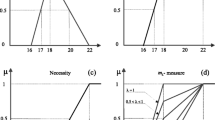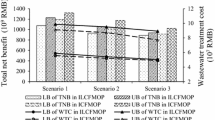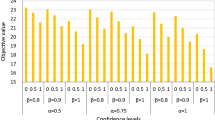Abstract
In this study, an inexact two-stage fuzzy gradient chance-constrained programming (ITSFGP) method is developed and applied to the water resources management in the Heshui River Basin, Jiangxi Province, China. The optimization model is established by incorporating interval programming, two-stage stochastic programming, and fuzzy gradient chance-constrained programming within an optimization framework. The hybrid model can address uncertainties represented as fuzzy sets, probability distributions, and interval numbers. It can effectively tackle the interactions between pre-regulated economic targets and the associated environmental penalties attributed to water allocation schemes and reflect the tradeoffs between economic revenues and system-failure risk. Furthermore, uncertainties associated with the decision makers’ preferences are considered in decision-making processes. The obtained results can provide decision support for the local sustainable economic development and water resources allocation strategies under multiple uncertainties.






Similar content being viewed by others
References
Beraldi P, Grandinetti L, Musmanno R, Triki C (2000) Parallel algorithms to solve two-stage stochastic linear programs with robustness constraints. Parallel Comput 26(13):1889–1908
Birge JR, Louveaux FV (1988) A multicut algorithm for two-stage stochastic linear programs. Eur J Oper Res 34(3):384–392
Cai Y, Huang G, Nie X, Li Y, Tan Q (2007) Municipal solid waste management under uncertainty: a mixed interval parameter fuzzy-stochastic robust programming approach. Environ Eng Sci 24(3):338–352
Chang NB, Wang S (1997) A fuzzy goal programming approach for the optimal planning of metropolitan solid waste management systems. Eur J Oper Res 99(2):303–321
Chen F, Huang G, Fan Y (2015) Inexact multistage fuzzy-stochastic programming model for water resources management. J Water Resour Plan Manag 141(11):04015027
Creaco E, Franchini M, Walski TM (2015) Taking account of uncertainty in demand growth when phasing the construction of a water distribution network. J Water Resour Plan Manag 141(2):04014049
Cunnane C (1988) Methods and merits of regional flood frequency analysis. J Hydrol 100(1):269–290
Dai C, Cai Y, Li Y, Sun W, Wang X, Guo H (2014) Optimal strategies for carbon capture, utilization and storage based on an inexact m λ-measure fuzzy chance-constrained programming. Energy 78:465–478
Ejeta MZ (2014) System stability in model complexity for integrated water management in California. J Water Resour Plan Manag 140(10):04014024
Fan Y, Huang G (2012) A robust two-step method for solving interval linear programming problems within an environmental management context. J Environ Inform 19(1):1–9
Guo P, Huang GH, He L, Zhu H (2009) Interval-parameter two-stage stochastic semi-infinite programming: application to water resources management under uncertainty. Water Resour Manag 23(5):1001–1023
Hu Q, Huang G, Cai Y, Sun W (2014) Planning of electric power generation systems under multiple uncertainties and constraint-violation levels. J Environ Inform 23(1):55–64
Huang G, Loucks D (2000) An inexact two-stage stochastic programming model for water resources management under uncertainty. Civ Eng Syst 17(2):95–118
Jiangxi Bureau of Quality and Technical Supervision (JBQTS) (2003) Water-using quotas of major industrial products in the province of Jiangxi. DB 36/T 420–2003
Jiménez M, Arenas M, Bilbao A, Rodrı MV (2007) Linear programming with fuzzy parameters: an interactive method resolution. Eur J Oper Res 177(3):1599–1609
Jinturkar A, Deshmukh S, Agarkar S, Chavhan G (2010) Determination of water quality index by fuzzy logic approach: a case of ground water in an Indian town. Water Sci Technol 61(8):1987–1994
Jordan YC, Ghulam A, Chu ML (2014) Assessing the impacts of future urban development patterns and climate changes on total suspended sediment loading in surface waters using geoinformatics. J Environ Inform 24(2):65–79
Li YP, Huang GH, Nie XH, Nie SL (2008) A two-stage fuzzy robust integer programming approach for capacity planning of environmental management systems. Eur J Oper Res 189(2):399–420
Li Z, Huang G, Zhang Y, Li Y (2013) Inexact two-stage stochastic credibility constrained programming for water quality management. Resour Conserv Recycl 73:122–132
Li T, Li P, Chen B, Hu M, Zhang X (2014) Simulation-based inexact two-stage chance-constraint quadratic programming for sustainable water quality management under dual uncertainties. J Water Resour Plan Manag 140(3):298–312
Li Z, Huang G, Cai Y, Li Y (2015) Inexact optimization model for supporting waste-load allocation in the Xiangxi River basin of the Three Gorges reservoir region, China. J Comput Civil Eng 29(6):04014093
Liang H, Zeng W, Jiang F (2014) Investigation of uncertainties in surface water resource assessment of Georgia’s state water plan. J Water Resour Plan Manag 140(2):228–237
Mance E (2007) An inexact two-stage water quality management model for the He river basin in Yongxin County. Master, University of Regina, Regina
Mandal U, Dhar A, Panda SN (2013) Integrated land and water resources management framework for Hirakud Canal subcommand (India) using gray systems analysis. J Water Resour Plan Manag 139(6):733–740
Maqsood I, Huang GH, Yeomans JS (2005) An interval-parameter fuzzy two-stage stochastic program for water resources management under uncertainty. Eur J Oper Res 167(1):208–225
Miao D, Huang W, Li Y, Yang Z (2014) Planning water resources systems under uncertainty using an interval-fuzzy de novo programming method. J Environ Inform 24(1):11–23
Murray A, Ray I (2010) Wastewater for agriculture: a reuse-oriented planning model and its application in peri-urban China. Water Res 44(5):1667–1679
Nie X (2010) Development of robust optimization methodologies for environmental systems management under uncertainty. University of Regina, Regina
Radko M (1997) Possibility measures, integration and fuzzy possibility measures. Fuzzy Sets Syst 92(2):191–196
Riegels N, Pulido-Velazquez M, Doulgeris C, Sturm V, Jensen R, Moller F, Bauer-Gottwein P (2013) Systems analysis approach to the design of efficient water pricing policies under the EU Water Framework Directive. J Water Resour Plan Manag 139(5):574–582
Sasikumar K, Mujumdar P (2000) Application of fuzzy probability in water quality management of a river system. Int J Syst Sci 31(5):575–591
State Environmental Protection Administration (SEPA) (2002) People’s Republic of China Environmental Quality Standards for Surface Water. GB3838–2002
Shah NA, Soni HA, Patel KA (2013) A fuzzy production inventory model with imprecise production and fuzzy production time under mλ-measure. Int J Math Comput 18(1):67–84
Tan Q, Huang G, Cai Y (2011) Radial interval chance-constrained programming for agricultural non-point source water pollution control under uncertainty. Agric Water Manag 98(10):1595–1606
Vogel RM, Wilson I (1996) Probability distribution of annual maximum, mean, and minimum streamflows in the United States. J Hydrol Eng 1(2):69–76
Wang LZ, Twang YF, Wang L, Wang GQ (2014) Pollutant flushing characterizations of stormwater runoff and their correlation with land use in a rapidly urbanizing watershed. J Environ Inform 23(1):44–54
Xu TY, Qin XS (2014) Integrating decision analysis with fuzzy programming: application in urban water distribution system operation. J Water Resour Plan Manag 140(5):638–648
Xu Y, Huang G, Cheng G, Liu Y, Li Y (2014) A two-stage fuzzy chance-constrained model for solid waste allocation planning. J Environ Inform 24(2):101–110
Yang L, Iwamura K (2008) Fuzzy chance-constrained programming with linear combination of possibility measure and necessity measure. Appl Math Sci 2(46):2271–2288
Yetilmezsoy K (2012) Fuzzy-logic modeling of Fenton’s oxidation of anaerobically pretreated poultry manure wastewater. Environ Sci Pollut Res 19(6):2227–2237
Zeng XT, Li YP, Huang GH, Liu J (2015) A two-stage interval-stochastic water trading model for allocating water resources of Kaidu-Kongque River in northwestern China. J Hydroinform 17(4):551–569
Zhang Y, Huang G (2010) Fuzzy robust credibility-constrained programming for environmental management and planning. J Air Waste Manage Assoc 60(6):711–721
Zhang W, Wang X (2002) Modeling for point–non-point source effluent trading: perspective of non-point sources regulation in China. Sci Total Environ 292(3):167–176
Acknowledgements
This research was supported by the Natural Science and Engineering Research Council of Canada. The authors are thankful to the editor and anonymous reviewers for their insightful comments, which have significantly contributed to improving the manuscript.
Author information
Authors and Affiliations
Corresponding author
Additional information
Responsible editor: Marcus Schulz
Rights and permissions
About this article
Cite this article
Xu, J., Huang, G., Li, Z. et al. A two-stage fuzzy chance-constrained water management model. Environ Sci Pollut Res 24, 12437–12454 (2017). https://doi.org/10.1007/s11356-017-8725-y
Received:
Accepted:
Published:
Issue Date:
DOI: https://doi.org/10.1007/s11356-017-8725-y




